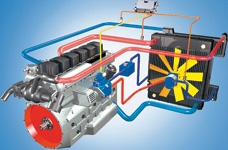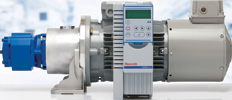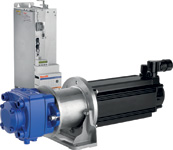
Global trends towards reducing energy consumption, paired with new carbon emission laws and taxes, have altered the way in which companies design and operate their machinery. Industries are changing the way in which they operate in order to become energy efficient and environmentally conscious while reducing operating costs and increasing productivity. In addition, companies worldwide are cutting costs because of a weakening Chinese market, which has decreased machinery demand by 40%; and the debt crisis in Europe continues to impact negatively on the investment climate.

Meanwhile Bosch Rexroth is constantly introducing innovative new developments in its drive and control technologies aimed at cutting energy consumption. The company will spend €370 million on research and development in 2013. This investment represents 5,7% of sales, which is way above the industry average. This is in line with its Rexroth For Energy Efficiency pledge (4EE), where the company aims to reduce its own carbon emissions by 25% within 10 years. Environmental responsibility also inspired the company’s two new programmes that were showcased at the Hannover Messe trade fair in April this year – Improve Energy Efficiency and Efficient Engineering.
The Improve Energy Efficiency campaign introduced Bosch Rexroth’s ready-to-install Sytronix solution, which can reduce energy consumption of hydraulic systems by up to 80%. Sytronix speeds up pump drives and increases the life of hydraulic fluid by reducing heat input.

The Efficient Engineering programme launched Open Core Engineering. This combines the previously separate PLC and IT worlds into one comprehensive portfolio with open standards, software tools, and function packages using the Open Core interface. It integrates traditional IEC engineering with the new capabilities provided by high level programming and gives enhanced access to the control core, allowing individual real-time control functions to be implemented quickly and independently.

Bosch Rexroth has also developed a system with IndraMotion MLC that can be preconfigured for hydraulic applications. Thanks to Open Core Engineering, users can access the control core from high-level language-based applications, enabling simpler, more individualised, more economical applications. Open Core Engineering won the prestigious international Hermes Award presented at Hannover Messe that singles out outstanding innovations pioneered by individual companies.
These two innovations are part of Bosch Rexroth’s holistic approach to reducing energy requirements, which focuses on optimising technologies, components and applications across an entire system. The Bosch Rexroth control systems are the result of the integration of modern hydraulic technology and components and modern electronic control systems. They are available in southern Africa through authorised distributor, the Hytec Group of Companies,
In order to achieve maximum energy efficiency in a hydraulic system, either primary or secondary hydraulic control systems must be used. Primary hydraulic system control regulates the flow, pressure and power delivered to a product through the use of electronics, while secondary control monitors and varies the hydraulic motor to meet demand requirements. The result is optimum delivery of energy to the external system on a continuous basis. The hydraulic pump backs off when no flow is required and stops drawing unnecessary power from the electric motor. The system can also sense when the demand will increase, and step up the supply accordingly.
“By integrating the pump control system with the plant’s electronic control system, exact supply and demand power can be achieved with very little energy wastage,” says Hytec general manager, Mike Harrison. “The system continuously monitors the demand and optimises the hydraulic flow and pressure to meet demands efficiently.”
Another energy efficient control option is the use of electronics to control variable displacement of axial piston pumps. These use the eccentric motion of a rotating swash plate to drive a ring of pumping pistons. The angle of the swivel is electronically adjusted to vary the flow produced by the pump. At a swivel angle of zero there will be no axial movement and hence no flow. As the swivel angle increases the stroke of the axial pistons increases, increasing the flow. By controlling the pressure precisely, this system ensures there is no wastage.
The inverter-based VSD is another energy efficient control system that varies the electric motor speed. It can also operate with less sophisticated hydraulic pumps. The VSD is the ideal way to improve efficiency for users of simple hydraulic systems. However, the versatile VSD can also be used to vary the electric motor speed for complex hydraulic systems by integrating primary control systems with the VSD. The VSD can make systems energy efficient by reducing the high current peaks associated with direct on-line starting. Soft starting the electric motor can reduce energy usage by lowering the peak power drawn during the startup. An additional benefit of the inverter-based VSD is that it requires little maintenance, making the VSD not only energy efficient, but cost efficient too.
The use of inverter-based VSD and primary motion control reduces energy requirements, as the system can operate with minimum power draw and motor speed. “While the external system is unloaded, for example if a bin is empty and there is no material on a feeder, then the belt can be stopped by de-stroking the pump using the VSD, and you can also run the motor down to its minimum speed. Electric motors even under no load conditions still draw 50% of their full speed, but their power consumption drops significantly,” says Harrison.
He believes that energy efficient solutions need to be implemented at the commissioning level. “We need to establish a balance between capital costs and the long-term savings that accrue across the lifecycle of a machine. Big end-users need to start specifying energy efficiency requirements in their tender documents. Unless they do this, all tenders will continue to be on a lowest cost basis and few of them will be energy efficient or cost competitive over the lifecycle of the machine.”
Although initial costs may be higher when taking the energy efficient route, there are many success stories about overall reduced costs with Bosch Rexroth integrated systems. Harrison recalls the success of a German innovation: cooling fan control of trucks and off-road vehicles. “Traditionally hydraulic motors have been used to drive cooling fans, but these simply speed up the fan with engine speed, regardless of the cooling requirements. To save energy, you add electronic control and a variable displacement pump. You monitor the cooling requirements, and if no cooling is required then the fan speed is reduced via the variable displacement pump. So around 30 kW of power can be made available for something else, or you can reduce the fuel consumption by an equivalent amount. Almost all German-built heavy duty machines use an efficient hydraulic system like this,” he says.
This illustrates how energy conscious design can be 15-35% more efficient. “A savings potential of 20 kW is achievable on a 160 kW system by going the energy conscious route,” adds Harrison. All Hytec systems are designed for a 100 000 hour lifecycle, which is approximately 12 years. At an average electricity cost, accumulated financial savings as a result of lowering energy consumption can amount to more than R1,4 million over the lifecycle of the system.
“Anyone who has a long-term focus on a company’s profitability will see this approach as the green and responsible thing to do and also the sensible choice for financial sustainability,” he concludes.
For more information contact Mike Harrison, Hytec, +27 (0)11 975 9700, [email protected], www.hytec.co.za
| Tel: | +27 11 975 9700 |
| Fax: | +27 11 975 8709 |
| Email: | [email protected] |
| www: | www.boschrexroth.africa |
| Articles: | More information and articles about Hytec South Africa |

© Technews Publishing (Pty) Ltd | All Rights Reserved